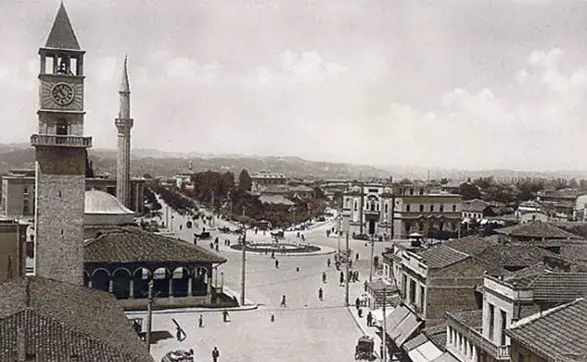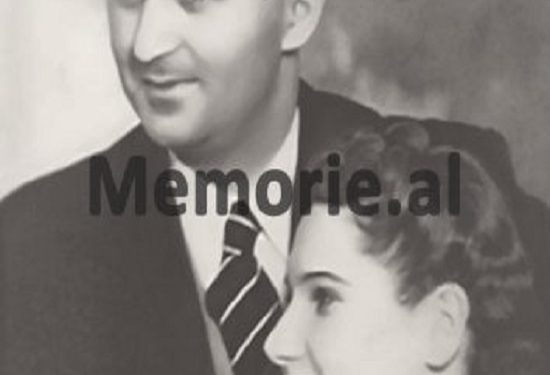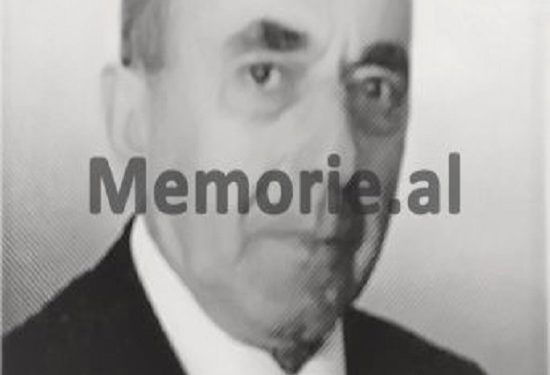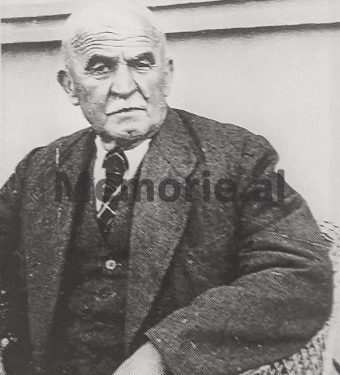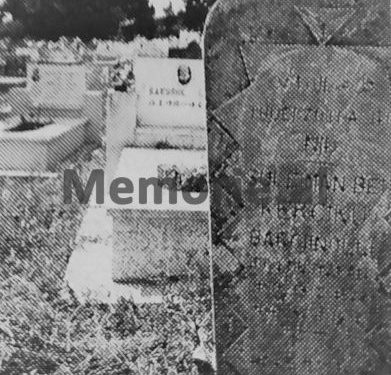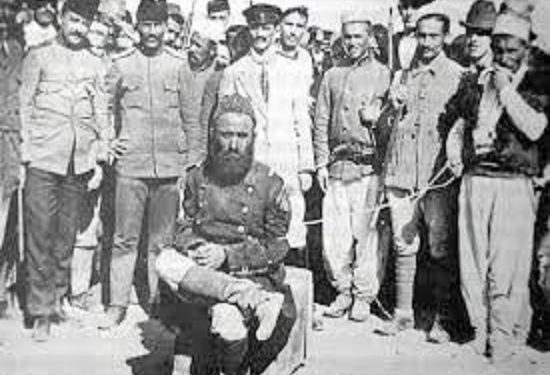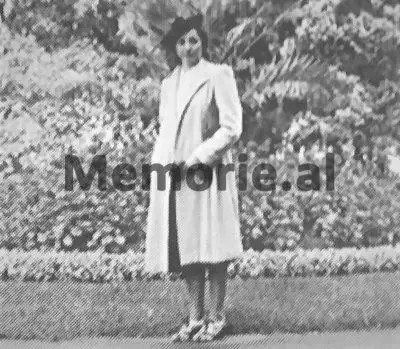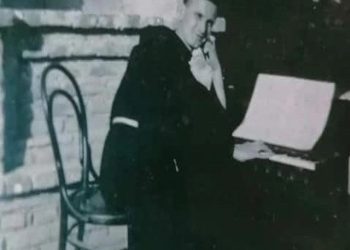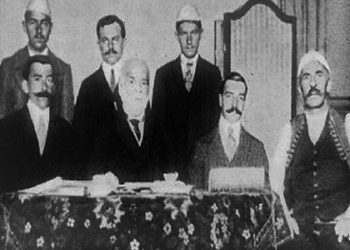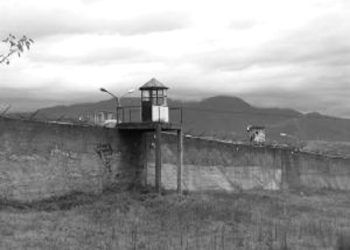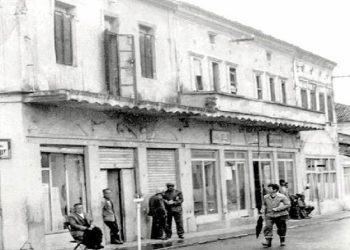Dashnor Kaloçi
Memorie.al publishes the unknown story of the famous Tirana family, Kërçiku, known as the descendant of Sulejman Pasha Bargjini, the founder of the city of Tirana, from which many famous suckers have emerged who have made a great name throughout the history of this city since 1920 it became the capital of Albania. Such was Sulejman Bej Kërçiku, the Tirana Police Commissioner who arrested Haxhi Qamil in 1914 when he was put in charge of a rebellious peasant movement in central Albania, and years later would be honored by King Zog for his contribution. great that he had given in Tirana by establishing order and tranquility. The whole story of Sulejman’s sons, from Hajdari who graduated in Austria and served for many years as chief architect of the Municipality of Graz, to Dr. Kadri Kërçiku, the famous doctor who made a great name in his profession until he passed away in 1972, as well as some of their descendants who suffered in the prisons of the communist regime of Enver Hoxha, as “enemies of the people”!
Sulejman Bej Kërçiku, Tirana Commissar who arrested Haxhi Qamil
One of those large Tirana families which has produced prominent men and has left its mark in the history of this city and all of Albania, is the family of Sulejman Bej Kërçiku, former commissioner of the Tirana Police, who among others is also known for the arrest of Haxhi Qamil in 1915. Also, from this well-known Tirana family which is the descendant of Sulejman Pash Bargjini, who is known as the founder of the city of Tirana, have emerged many other suckers known as the doctor of renowned dermatologist, Prof.Dr. Kadri Kërçiku, or his brother, Hajdari who after graduating from the University of Graz, managed to be appointed and work for years as chief architect of the Municipality of that famous Austrian city, Graz. Regarding the painful history of this well-known Tirana family, which was hit and persecuted by the communist regime of Enver Hoxha, we know Dr. Kërçik’s nephew, Gëzim Peshkëpia, a former teacher who suffered for eight years in the prisons of the dictatorship.
Kërçiku, descendant of Bargjini
Sulejman Bej Kërçiku was born in 1873 in the city of Tirana, where his family comes from, which is known as the descendant of the family of Sulejman Bej Bargjinolli, as the founder of the city of Tirana is called, who laid the first stones in the foundation of the mosque in center of the future capital since 1618. Suleiman’s father, was Mustafa, who was born in 1841, while Mustafa’s father was Haxhiu. The existence of Sulejman Bej Kërçik and other suckers of that family as descendants of the founder of the city of Tirana, is also known from the inscriptions that are today on the tombstones of the ancestors of this tribe, such as Haxhi Bej Vogli (Kërçiku), Mustafa Bej Kërçiku (Bargjinolli), Sulejman Bej Kërçiku (Bargjinolli) and Shyqëri Kërçku (Bargjini). These tombs were originally in the courtyard of the mosque which existed where today is the monument of the “Unknown Soldier”, the mosque which is known by the name of the man who built it and then those tombs were moved two more times to “Vorrin e Bamit” and finally to Tufina, where the remains of the Bargjinolls are still buried. The houses and shops of the Bargjinolli or Kërçiku family, as they were later known, are very close to the New Bazaar (at Avni Rustemi Square) and they were located as far as the “Partizani” cinema. The first members of the Kërçiku family and later their descendants, have been known as large landowners, as their properties extended as far as Babrru. Given this, they are not distinguished for any kind of handicrafts, but are constantly engaged only in the administration of their lands and properties.
Sulejman Bej Kërçiku, commissar of Tirana
Among the most famous men of this family, was Sulejman Bej Kërçiku, son of Mustafa Bej Kërçiku who was born in 1880 in the city of Tirana. After receiving his first lessons in Turkish in the city of Tirana, Sul Kërçiku was sent to continue his studies at a military (high) school in Istanbul. After graduating from that school, in the last years of the 18th century, Sulejmani returned to his hometown and was immediately appointed to the ranks of the Thessaloniki police, where in the function of the Commissar of that police, was Esat Pasha Toptani. Regarding the period that Sul Kërçiku served in the ranks of the Thessaloniki police and later as the Police Commissar of Shijak and Tirana, his nephew, (daughter’s son) Gezim Peshkëpia, recalls: “From my mother I heard a lot of talk about our grandfather, Sul Kërçikun, especially for the period he was in Thessaloniki and Tirana. After serving for several years in the Thessaloniki Gendarmerie, Sula was transferred to the position of Police Commissioner of the small town of Shijak, where he served for several years. During the time that Sula was serving in that city, he married a girl from the Deliallis family, named Hajrie, who was the daughter of Abdullah Bey Deliallis and the only sister of four brothers. From this marriage five children were born: Shyqëriu, Hamdiu, Kadriu, Nadirja and Hajdari.
How did he find the kidnapped girl?
Regarding the period that Sulejman Bej Kërçiku served in Tirana with the duty of Police Commissioner, Mr. Peshkëpia narrates: “Even in Tirana, as in the city of Shijak, my grandfather, Sula, did a great job in establishing order and keeping calm, effectively using a whole network of very strong secret agents, who they informed him about everything that was happening in the prefecture of Tirana. My mother told me that at that time, a villager from the highlands of Tirana abducted a 15-year-old girl from the village of Ibë, whom he sent to his house with the intention of marrying her. The kidnapping of the girl caused a commotion and her family came to Tirana, complaining and asking for Sulë’s help. After being informed, Sula immediately organized the plan to find the minor girl and at the head of 40 police agents, left for the highlands of Tirana, where it was suspected that the robbed girl was. For a short time, he found her whereabouts and after surrounding the house with his people, alone, entered inside surprising the owners of the house and after that, Sula entered into talks with the people of the house and the girl who from fear did not speak. Sula took the 15-year-old girl with him and to assure her that nothing would happen to her, he took her to his house, where she grew up and the bride came out of that house which was treated like all the other members. of the family of Sul Kërçik.
How did Haxhi Qamil get arrested?
But one of the events that gave a great name to the Tirana Police Commissioner, is that of 1914, when Sul Kërçiku managed to arrest, Haxhi Qamili, from Sharra of Tirana, who had self-appointed as “Military Commander of the movement of the peasants of Central Albania”. Regarding this event, Gëzim Peshkëpia says: “My mother gave the uncles, they told me about my grandfather, who managed to arrest Haxhi Qamil, after he was put in charge of a rebel movement, becoming the horror of the rich families of the beys of Central Albania, who burned their houses and looted their property. At the time when the “Peasant Movement” started, led by the Mufti of Tirana, Musa Qazimi, our grandfather Sula, was forced to go to the mountains as a fugitive, because Haxhi Qamili burned down his houses, flattening everything. But after some time, he stayed as a fugitive, (hidden) Sula went back to Tirana, where after gathering some of his loyal people, he left with them in the direction of Shijak, where Haxhi Qamili had his house. After making the plan to capture him, avoiding a fight with the forces of Hajji Qamil, he managed to capture him alive by tying his hands and feet. After that, Sula insisted to Esat Pasha that Haxhi Qamili should not be executed, but should be imprisoned and tried according to all the rules and laws of that time “, Gëzim Peshkëpia tells about his grandfather, who in 1914, managed to arrest the rebel Haxhi Qamil, who was then hanged in the middle of Shijak.
Replacement by King Zog
In 1920, when Serbian forces reached the Tujan Stairs in the north-east of Tirana, Sulejman Bej Kërçiku personally participated in the resistance against them by government forces commanded by Osman Gazepi and volunteers led by Qazim Mulleti. Regarding this Mr. Peshkëpia says: “As my mother told me, when our grandfather Sula with some of his police forces went to the aid of the Army in Tujan Stairs, this surprised Ahmet Zogu who was present there. After the 1920s, when the political life in Tirana began to deteriorate, Sula withdrew to private life by not interfering in any of the political forces that were fighting at that time between them to come to power. In the beginning of 1924, Sulë’s eldest son, Shyqëriu, joined Avni Rustemi in the organization “Bashkimi”, but Sula advised him to give it up and since then Shyqëriu did not participate in any of its activities. company, and yet he was fired from the Post-Telegraph. As a sign of respect for the activity and contribution he had given during his service as Tirana Police Commissar and participation in the Tujan Scale war against Serbian forces, in 1928, King Zog paid a visit to the house of Sulejman Bey Kërçik, highly appreciated the service he had rendered to the city of Tirana. Sulejman Bey Kërçiku, who was also a great believer of the Islamic religion, died in 1940 at the age of 67, being taken to his last home with all the honors and respect by the official authorities of that time.
Shyqëri Kërçiku, in the Postal Directorate
Sulejman Bej Kërçiku with his wife Hajrie Deliallis, left five children, who had different fates in life. The eldest of them was Shyqëriu who was born in 1901 in Tirana. Regarding his life, Gëzim Peshkëpia, the nephew of the Kërçiku family, says: “Shyqëriu, the eldest son of the Kërçiku family, unlike the other brothers, had not completed any high school, but went to school in the city of Tirana for several years. He had taken a qualification course that had been opened at that time by the General Directorate of Telegraph Post and for some time he had worked at the Tirana Post. Shyqëriu was married to a girl from the famous family, Peza, named Nadire and from this marriage five children were born: Naimi, Faiku, Estrefi, Skënderi and Liljana. After Zog came to power, in the early 1925s, Shyqëriu was fired, due to his younger brother, Hamdi, known for his anti-Zogist tendencies. From that time on, Shyqëriu took over the administration of his family’s agricultural properties and lands which were located in Babrru. Even after 1945 when the communists came to power, Shyqëriu again took over the administration of his family’s properties. He passed away in the mid-1980s, at the age of 86, with great concern over the arrest and conviction twice by the communists of his third son, Estrefi, who worked as a welder at the Construction Company. “December 21” in Tirana. Estrefi suffered over 13 years as a political prisoner in the camps of the communist regime of Enver Hoxha. “Shyqëriu had five children, two of whom, Naimi and Faik, graduated as engineers and worked as surveyors and builders.”
Hamdi Kërçiku, President of the Chamber of Commerce
The second son of Sulejman Bey Kërçik, was Hamdiu who was born in 1903 in Tirana. After graduating from elementary school, he enrolled and attended Harry Fultz American Technical School, where he graduated with honors. Hamdi was fluent in English and translated the New York Times news agencies for the press office of the then government. After graduating from this school in 1927, Hamdi was held there, being appointed caretaker of the boarding school, which he held throughout the period of the Zog Monarchy. During the Italian occupation of the country, Hamdiu worked as President of the Tirana Chamber of Commerce and in the late 1930s, he married Fitret, the Prime Minister’s sister, Mustafa Merlika Kruja. During the war, Hamdi Kërçiku was a sympathizer of the nationalist organization “Balli Kombëtar” and his political convictions were deeply anti-communist. At the end of 1944, knowing how the communists would treat him, because of his kinship with the Merlika family. Hamdiu, left Albania and initially settled in Italy and Austria. In the early 1950s, he fled Austria and settled in the United States, where Hamdi graduated with a degree in Finance. After graduation he worked for many years as a finance clerk. While his wife, Fitreti, with her three daughters, suffered for years in internment camps. She was a noble woman of character who worked with the wife of the academic officer, Reshat Stërmasi, Nafije, and the wife of the former MP, Irfan Majuni (both shot in 1947) Feriden, working as a construction worker… Hamdi passed away in 1978 and he left three daughters: Aphrodite, Mirgjina and Gjeraqina, who now live in Berlin.
Prof. Dr. Kadri Kërçiku, well-known doctor
The third son of Sulejman Baj Kërçik, was Kadriu, who was born in 1905 in Tirana and has been known almost throughout Albania, as one of the best doctors in our country. Regarding the life story of Dr. Kadri Kërçikut, his nephew, Gëzimi Peshkëpia says: “After finishing primary school in Tirana, he went to Austria where he studied for 16 years, graduating from the Faculty of Medicine in Vienna where he specialized in Dermatology. In the early 1930s, King Zog called Dr. Kërçik in the Palace and proposed that he serve as his family doctor. But Kadriu refused, saying to Zog: “As you know, I specialize in venereal diseases and if I work for you, your political opponents will take advantage of this and attack, saying that there are problems in your yard. of this nature”. After these words, King Zog approached his window and said to Dr. Kadriu: “Those houses that are being built there at the New Bazaar, are yours? Go and finish those houses” and slapped him on the shoulders. Zogu said those words, because Dr. Kërçiku also worked at the Civil Hospital of Tirana, and in his private clinic, where the queues of people waiting to be visited were constantly increasing. At the end of 1944, Dr. Kërçiku entered into talks with the German general, Fizztum, and influenced the Tirana Civil Hospital not to be blown up, in revenge for an action carried out by the communists near the Madrasa, where 16 Nazi soldiers were killed. Even after the end of the War Dr. Kadri Kërçiku continued his profession, managing to become one of the most famous doctors, who passed away in 1972, at the age of 67.
Hajdar Kërçiku, chief architect of Graz
The youngest of the brothers, Kërçiku, was Hajdari who was born in 1912 in Tirana. Like his brother, Hamdiu, Hajdari attended the Fultz American Technical School in Tirana and at the age of 17 he went to Austria where his brother, Kadriu, studied and enrolled at the Faculty of Architecture in Vienna. Even after graduation, Hajdari did not return to Albania, but stayed in Austria, where he married an Austrian girl named Leopoldina Lukan, who later won the title “Professor” which was handed over to him by the then President of Austria. In the years that followed, Hajdari’s wife, Leopoldina, gained great fame as a painter-restorer, doing some very large work on ancient objects in various parts of Europe. While Hajdari managed to become the chief architect of the Municipality of Graz in Austria and during those years he served in that position, he designed some very good works, among which it is worth mentioning a hospital for nuns who specialized in nursing and a bank for trade unions. During the years of Enver Hoxha’s communist regime, Hajdar Kërçiku was allowed several times to visit the families of his two brothers in Tirana, as he had helped the Albanian government several times with the problems of Trade with Austria. As a sign of gratitude for what he had done for the Albanian state, in 1968, he was officially invited by the Albanian government to participate in the celebrations of the 500th anniversary of Skanderbeg’s death, with the status of President of the Albanian Colony of Austria. “Hajdar Kërçiku passed away in 1980 and he left two daughters, Mirjamin who works as a teacher of Art History in an art school in Graz and Hajrien, who is a lecturer at the University of Munich in Germany”, says Gëzim Peshkëpia, for his uncle his, Hajdari who managed to become the chief architect of the Municipality of Graz and his family. In addition to four sons: Shyqëri, Hamdi, Kadri and Hajdari, Sulejman Bej Kërçiku also had a daughter Nadiren, the mother of Gëzim Peshkpopija, who married Manush Peshkëpinë, who was executed in 1951 by the communist regime of Enver Hoxha, being charged for the “bomb incident at the Soviet embassy” in Tirana. While her two brothers Kadriu and Hajdari were studying in Austria, they took with them their sister, Nadir, who was taking a home economics course at a college of nuns. After spending many years in exile, Nadiri passed away in 1981, leaving two children, Xhanfize and Gëzim, who suffered for 8 years in prison in the political prisons of the communist regime of Enver Hoxha. This is how the life of the five children of the former Tirana Police Commissioner, Sulejman Bej Kërçiku, went, whose family was looked down upon during the communist regime, being considered a bourgeois and reactionary family. She could escape further suffering, only in her Prof. Dr. Kadri Kërçikut, the well-known dermatologist who needed him so much. / Memorie.al






